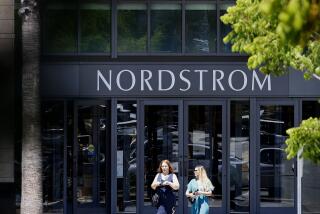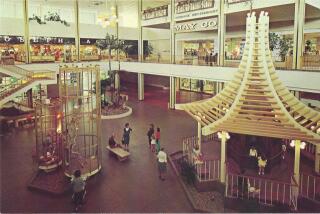High-Tech Buying : In the Future, You’ll Be Able to Drain Your Pocketbook Without Lifting a Finger
- Share via
In the future, experts tell us, television shopping will be astoundingly simple. Consider this scene from a Nordstrom marketing video:
*
A perky young woman perches on an overstuffed sofa for a friendly chat with her . . . TV. “Access a shopping channel, please,” she orders politely, then tells the set to show her merchandise from a specific store (guess which one?). The shopper asks to see evening wear and, posthaste, a friendly Nordstrom saleswoman appears on screen, describing the delights of a sheer blouse. Worn under a jacket, the blouse can go to the office. Over a camisole, it’s ready for a night on the town!
Without lifting a finger or finding a parking space, our heroine has completed her shopping. By the time she asks the television to turn itself off, a central dispatching area has received the order.
Interactive television shopping is coming to a TV set near you. But not for seven to 10 years. Before the futurists have their shopping day, several developments must occur:
* A two-way connection between the customer and the cable company. Right now it is only a one-way system--they send to you, but for the most part, you cannot respond. (Interactive Network Inc., based in Mountain View, Calif., is working on that end of the problem.)
* The development of hardware. Interactive shopping requires sophisticated cable converter boxes, smarter television sets and a fiber-optic cable that connects the hardware to cable operators. (In April, cable equipment manufacturer General Instrument joined with software maker Microsoft and microchip maker Intel to develop a cable converter box that functions like a personal computer. Tele-Communications Inc., the largest cable operator in the country, is spending $2 billion on a fiber optic network to create a system that can carry as many as 500 channels.)
* Enough programming to fill hundreds of channels and give consumers reason to pay the approximately $200 the new converter boxes will cost. (Video-game manufacturers such as Sega and shopping giants like Macy’s plan to be ready with their own channels when the time comes.)
Even though interactive shopping won’t be ready for awhile, the industry has already made a giant leap forward. Last week’s announcement of R.H. Macy & Co.’s 24-hour cable shopping channel, set to begin next fall.
In a model that mirrors the evolution of shopping in America, QVC and Home Shopping Network are the general stores of video shopping, selling silk blouses and gold-tone jewelry, pots, pans and books. TV Macy’s is about to invade their turf with a name-brand collection of merchandise that will challenge the generalists much like the specialty stores did when they moved onto Main Street early this century.
In the next logical step, cable shopping will resemble malls, with big specialty stores serving as prime-time anchors and programs from smaller stores filling out the rest of the broadcast day. A prototype for this stage, “The Mall of America Show,” is scheduled to air today on NBC featuring merchandise from Bloomingdale’s, Nordstrom and other stores.
What does all this mean for merchants? Cable and fashion-industry watchers say the medium could obliterate some conventional retailers. R. Fulton Macdonald, president of International Business Development Corp., told Women’s Wear Daily, “In 25 years QVC could could be the biggest retailer in the country.”
But the big names on shopping bags are not about to accede preeminence without a fight. Saks Fifth Avenue tested the QVC waters in late May. The show was so successful that the chain will return for another hour of television sales on June 19. Bloomingdale’s executives have crossed state lines to check out QVC headquarters in West Chester, Pa.
The retail companies that are most likely to be the first on the video block will be the ones that have strong name recognition and an existing mail-order operation that can handle the phone calls and fulfill the orders. Even then it is such new ground that Macy’s, for example, has asked Home Shopping Network to handle the filling of orders. Good service and timely deliveries will be as important for cable as it is for the stores.
Nordstrom, which is looking for partners for an interactive cable-shopping venture, has found there are strong similarities between video shoppers and catalogue shoppers. They are the exhausted folks who have about 30 minutes to call their own in the evening before they collapse into bed.
“The catalogue shopper is looking for convenience,” says Patrick Adkisson, a Nordstrom spokesman. “So is the video shopper. They have full lives, jobs, kids that have to be taken to soccer games and Scouts and they don’t have time to go shopping. Shopping used to be a leisure chore. Now it is just a chore.”
The only stumbling block to all this video shopping and advanced television is the customer. “The consumer interfaces have to be simple,” says Adkisson, “Consider how many VCRs in America are still flashing ‘12:00.’ ”
More to Read
Inside the business of entertainment
The Wide Shot brings you news, analysis and insights on everything from streaming wars to production — and what it all means for the future.
You may occasionally receive promotional content from the Los Angeles Times.










